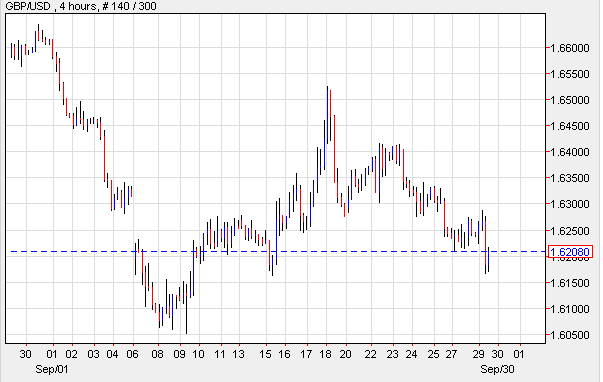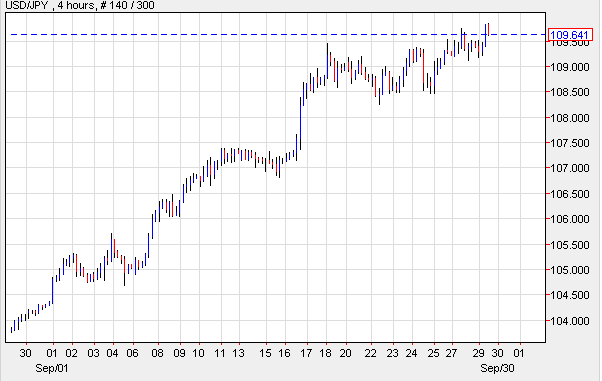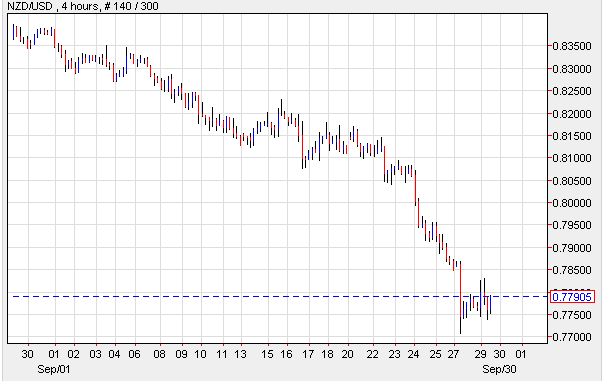The U.S. Dollar continued to advance against the majority of its Forex counterparts and climbed to the highest rate in four years while the Euro slumped further. Appeal for the greenback remained high subsequent to Monday's economic releases which pointed to higher Consumer Spending as a result of improved sentiment over the economy. Currently, speculators are waiting to see what Friday's Non-Farm Payroll reports will reveal, though they anticipate that the Federal Reserve will go ahead with a hike in the costs of borrowing money by spring of 2015. On the data front, the U.S. confirmed that Pending Home Sales sustained a drop of 1.0 percent after gaining 3.3 percent in August. Analysts say this offers a mixed picture, since Existing Home Sales failed to meet expectations.
Gold Prices traded to the downside, touching the lowest level since January. Experts in the money market predict that the shiny metal may sustain further declines in 2015 as the U.S. prepares for higher borrowing costs. The precious commodity has erased 6.3 percent of its advance in September, and it's said to be within 0.4 percent or erasing the remainder of this year's rally. Allure for gold is expected to decline as the Dollar continues to strengthen. Bullion for immediate delivery dropped 0.8 percent and traded at $1,206.39 in London, while Futures for December delivery plunged to $1,206.60 an ounce on the Comex. Analysts say that as the prices go down, buyers will be inclined to buy more gold; however, they don't expect a hike in physical demand unless the commodity reaches $1,100.00 a troy ounce.
The Euro traded at a new low against the U.S. Dollar following disappointing news which confirmed that the region's Inflation hit a five-year low, supporting the case for new measures by the ECB to fight deflation. Other announcements indicated that Germany's Unemployment went up, prompting investors to worry about the future of the region's economy. The British Pound on the other hand rebounded against the U.S. Dollar on news that the Gross Domestic Product expanded faster than predicted. Additional reports pointed to a hike in wages and a surge in household savings. Unfortunately, the Current Account Deficit widened, and Home Values dipped in September.
The Yen rose against the greenback and traded close to a six-year high on expectations the Federal Reserve could raise the key cash rate soon. Market traders continued to monitor the crisis in Hong Kong, where protestors marched the streets, interrupting activities in the financial sector.
And the New Zealand Dollar went up against its U.S. peer despite lackluster data which pointed to a drop in Building Consents and the ANZ Business Confidence Index. The Kiwi shrugged off disappointing metrics out of China denoting that the HSBC Manufacturing Purchasing Manager's Index declined from 50.5 to 50.2 in September. Australia's Dollar traded somewhat higher, although its advance was limited as reports indicated that iron ore sustained the third consecutive quarter of losses in what economists called the worst losing streak in history. The decline resulted from a slowdown in the Chinese economy. Sources say that China's economy has come to a halt as the real estate sector and retailers are still struggling. Should the stockpiles in China's ports decline, it's possible that iron ore could see a small increase in price by the end of 2014.
EUR/USD- Inflation Dampens Outlook
The EUR/USD reached a two-year low once again, after official reports indicated that the Euro-zone's Consumer Prices climbed at an annual 0.3 percent in September, after coming in at 0.4 percent in August. The statistics office located in Luxembourg added that Core CPI which doesn't take into account food or energy prices went up by a seasonal adjusted 0.7 percent after increasing 0.9 percent in the month of August. Other announcements were just as disappointing as they denoted that Germany, the region's largest economy, and the key to the E.U.'s recovery posted data indicating that the number of unemployed persons went up by almost 13,000 while economists expected to see a decline by 2,000. The country's rate of joblessness stayed at 6.7 percent. On the positive side, Germany announced that its Retail Sales climbed 2.5 percent in August, more than the expected 0.5 percent. The EUR/USD traded at the lowest rate since September of 2012 after announcements divulged that the E.U.'s level of Unemployment came in at 11.5 percent. According to economists, the drop in the rate of inflation is the result of lower energy prices, as these went down 2.4 percent. With such dire figures, it's likely the European Central Bank may step up its efforts to ensure the region's economy gains momentum.

GBP/USD- Growth Stokes Speculation
The GBP/USD rose on growth data, but erased gains soon after announcing that the Current Account widened in the second quarter. Official releases indicated that the British economy expanded faster than expected in the months of April to June, prompting the nation to emerge from a recession. The Office for National Statistics showed the Gross Domestic Product increased 0.9 percent, signaling that the recovery has occurred at the quickest pace in close to one year. The statistics office made modifications to data published in 2008 and denoted that the recession was not as serious as previously announced. The GDP Index came in a 2.7 percent higher than it was back at the beginning of 2008. But not all the news was positive. The Current Account deficit grew to 23.1 billion Pounds after printing at 20.5 billion Pounds in the first quarter of 2014. And lastly, the Nationwide Building Society stated that House Prices dropped 0.2 percent in September, failing to rise the predicted 0.5 percent. Construction data was modified to show a hike of 0.7 percent, suggesting that the U.K.'s economy has progressed more than previously thought.

USD/JPY- Yen Advances
The USD/JPY eased following lackluster announcements out of Japan confirming that activities in the Industrial sector declined in August by 1.5 percent, after going up 0.4 percent in the prior month. The Ministry of Trade stated that the sector has slowed down, after growing at the quickest pace in January. A vast number of companies had increased output to catch up with the hike in demand especially since individuals were purchasing more ahead of the April sales tax increase. Other publications revealed that spending among consumers has dropped more than predicted. Data shows that household consumption plunged 4.7 percent.

NZD/USD- Index Posts Decline
The NZD/USD rose, retreating from a one-year low subsequent to the announcement of domestic news divulging that the ANZ Business Confidence Index plummeted to 13.4 in September, the lowest reading in over twenty-four months. The Index came in at 24.4 in the prior month. Furthermore, releases indicated that Building Consents posted flat for August, subsequent to printing a drop of 1.7 percent in July. The NZD/USD recouped slightly after it dipped to a new low on news that the Reserve Bank intervened in the market, selling a dramatic amount of currency in August.

Today's Outlook Today's economic calendar shows that the Euro region and the U.K. will report on Manufacturing PMI. The U.S. will issue the ADP Non-Farm Employment Change, ISM Manufacturing Employment, and ISM Manufacturing PMI. Australia will provide data on HIA New Home Sales, Building Approvals and Trade Balance.
